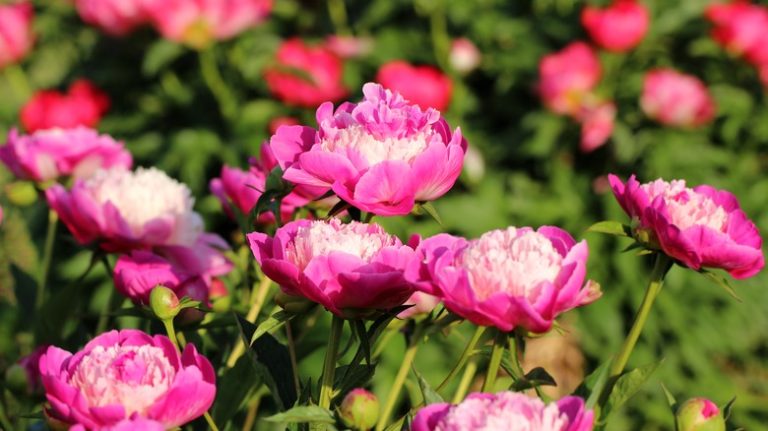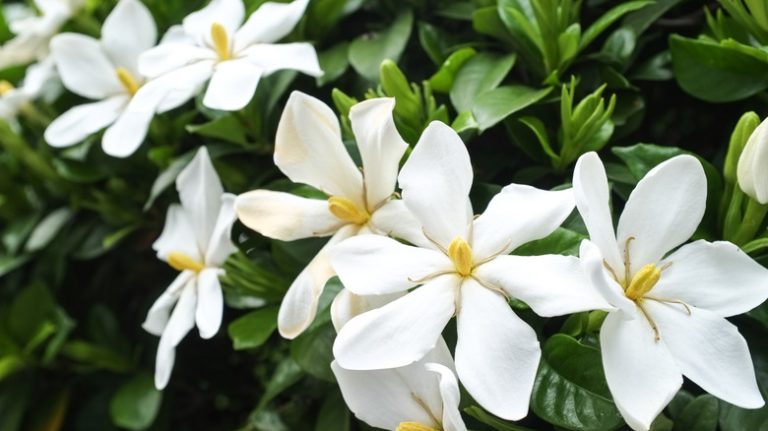Nasturtiums are a popular choice for gardeners of all skill levels, thanks to their hardy nature and vibrant colors. Whether you want to add a splash of orange to your garden or grow them as a food source, nasturtiums are a versatile and easy-to-care-for plant.
These annuals are mostly grown from seeds, although they can be propagated from cuttings as well. If you’re starting from seed, make sure to plant them after the last frost in well-drained soil. Nasturtiums are known for their heat tolerance, so they can be planted in areas with hot and dry climates.
Nasturtiums come in a variety of colors and sizes, from the classic orange empress to the raspberry twist. Their foliage is also appealing, with their round leaves adding an interesting profile to your garden. These plants are not only beautiful, but they also have edible flowers and leaves that can be added to salads and other dishes.
Once they are planted, nasturtiums will grow quickly and produce buds within a few days. The flowers will bloom throughout the growing season and can be harvested for their vibrant color and unique flavor. Don’t forget to pinch back the new growth to encourage bushier plants.
If you live in a frost-free area, you can enjoy nasturtiums as perennials. In colder areas, it’s best to treat them as annuals and replant them every year. Regardless of your location, nasturtiums are a low-maintenance and rewarding addition to your garden.
So next time you’re thinking of adding some color and twist to your garden, consider growing nasturtiums. They are a hardy and easy-to-grow plant that will provide you with beautiful flowers and edible foliage. Plus, the variety of colors and flavors they offer will make every harvest a delightful surprise.
“The empress of all nasturtiums, with its vibrant orange flowers, is a true showstopper in any garden.”
Edible of the Month: Nasturtium
Nasturtiums are a popular choice among gardeners due to their vibrant colors and edible foliage. These annual plants are easy to grow and can add a pop of color to any garden or plate.
Planting nasturtiums in Alaska can be challenging due to the shorter growing season and colder temperatures. If you still want to grow them in this region, it is recommended to start planting them indoors 4-6 weeks before the last frost date. This will give the seedlings a head start and increase their chances of thriving.
When planting nasturtiums, make sure to choose a well-drained location in your garden. These plants prefer full sun but can tolerate some shade. Space the seeds or seedlings about 10-12 inches apart to give them room to grow into bushy plants.
Nasturtiums are mostly grown as annuals, but they can also be perennial in some areas. In warmer climates, they may come back year after year. However, in colder regions, they might not survive the winter.
To propagate nasturtiums, sow the seeds directly in the ground after the danger of frost has passed. Nasturtiums are quick to germinate, and you’ll start to see their beautiful flowers in about 7-10 days. These plants are known for their unique foliage and look great in borders or as a backdrop in the garden.
Nasturtiums are available in a wide selection of colors, ranging from bright oranges and yellows to deep reds and raspberry tones. They not only add beauty to your garden but also make an excellent addition to salads or as a garnish for various dishes. Their flowers and buds have a peppery taste that adds a unique flavor to meals.
If you want to harvest nasturtiums for their flowers, do so when they are in full bloom. The flowers are at their most flavorful during this time. Nasturtium leaves can also be harvested and used in salads or other dishes. The leaves have a slightly milder flavor compared to the flowers.
Take care of your nasturtium plants by watering them regularly, especially during dry spells. These plants don’t require much fertilization but can benefit from well-amended soil. Add compost or organic matter to the soil before planting to provide extra nutrients.
In summary, nasturtiums are a versatile and colorful addition to any garden. Whether you’re looking for a beautiful flower or an edible plant, these flowers are an excellent choice. With the right care and attention, you can enjoy their vibrant colors and peppery flavor throughout the year.
Planning
When it comes to growing nasturtiums, a little bit of planning goes a long way. Before you start caring for your nasturtiums, you’ll want to consider a few important factors.
Soils: Nasturtiums are not very picky when it comes to soil types. They can thrive in a variety of soils, including clay, sandy, or loamy soils. However, they do prefer well-draining soils, so be sure to amend the soil if needed.
Site Selection: Nasturtiums can be grown in containers or directly in the ground. If you choose to grow them in containers, make sure to select a container with adequate drainage holes. If you plant them in the ground, choose a sunny location with at least six hours of sunlight per day.
Hardiness: Nasturtiums are annual plants that are very hardy and can withstand a wide range of temperatures. They prefer temperatures between 55-75°F (13-24°C) but can tolerate both hotter and cooler weather.
Sowing Time: Nasturtiums can be sown directly in the garden after the last frost date in your area. If you want to get a head start, you can also start seeds indoors about 4-6 weeks before the last frost date.
Propagation: Nasturtiums can be grown from seeds or transplants. If starting from seeds, sow them about 1 inch apart and 1/2 inch deep. For transplants, plant them about 12 inches apart to allow for their bushy growth.
Flowering Time: Nasturtiums are fast-growing plants that typically start flowering within 8-12 weeks from sowing. Once they start flowering, they will continue to produce vibrant flowers throughout the growing season.
Edible Varieties: Nasturtiums are not only beautiful but also edible. They have a unique peppery flavor and are often used to add a twist to salads, sandwiches, and other dishes. If you enjoy growing your own food, nasturtiums are a great choice.
Harvesting: Nasturtiums produce both flowers and foliage that can be harvested. The flowers are especially popular for their rich nectar, which attracts hummingbirds and butterflies. The leaves and flowers can be picked as needed throughout the growing season.
Source: Nasturtiums: How to Grow and Care for Nasturtium Plants. (n.d.). Retrieved from [источник]
Site Selection
When planning to grow nasturtiums, it is important to choose the right site for optimal growth and harvest. Nasturtiums are hardy annuals that can also be grown as perennials in frost-free areas.
Choose a location where the nasturtiums will receive full sun for at least six hours a day. While they can tolerate partial shade, they will produce fewer flowers than in full sun.
It is best to plant nasturtiums in well-drained soil that has been amended with organic matter. They have low nutrient requirements, so heavy fertilization is not necessary. However, adding compost or aged manure before planting can improve soil fertility and drainage.
Nasturtiums are known for their ability to thrive in poor soil conditions, and they will grow well even in areas with rocky or sandy soil. They can tolerate drought and neglect, making them a perfect choice for low-maintenance gardens.
They can be grown in borders, containers, or hanging baskets. If you choose to grow them in containers, make sure the containers have drainage holes to prevent waterlogging.
When selecting a site, consider the height of the plant. Nasturtiums can grow up to 12 inches tall and spread about the same distance. Give them enough space to grow by planting them at least 10-12 inches apart.
Nasturtiums are not frost-tolerant, so avoid planting them until all danger of frost has passed. In regions with a short growing season, you can start the seeds indoors 4-6 weeks before the last expected frost date and then transplant the seedlings outside when the weather warms up.
One interesting fact about nasturtiums is that they are attractive to beneficial insects like bees and butterflies. These insects are important for pollination, so having nasturtiums in the garden can help support a healthy ecosystem.
In summary, when selecting a site for growing nasturtiums, choose a sunny location with well-drained soil. Provide enough space for the plants to grow, and consider starting the seeds indoors if you live in an area with a short growing season. By selecting the right site, you can ensure the success of your nasturtiums and enjoy the beautiful flowers and foliage they produce!
Planting
When it comes to planting nasturtiums, they are quite versatile and can be grown as perennials or annuals, depending on your gardening goals. These bushy and hardy plants will thrive in almost any type of soil and can tolerate a bit of neglect.
If you live in an area with a shorter growing season, it is recommended to start nasturtiums from seedlings, rather than sowing them directly in the garden. This will give them enough time to establish before the frost sets in.
Choose a location in your garden where nasturtiums will receive full sun or partial shade. They prefer well-drained soils, but can also tolerate less ideal conditions. If your soil is heavy or clay-like, you can amend it with compost or well-rotted manure to improve drainage.
Nasturtiums are known for their vibrant flowers and foliage. They come in a variety of colors, from bright oranges and yellows to deep reds and raspberries. A popular variety is ‘Alaska’, which has variegated foliage and can add a splash of color to any garden.
Before planting, make sure all danger of frost has passed. Nasturtiums are quite hardy and can tolerate cooler temperatures, but they will not survive a hard frost. In frost-free areas, you can plant them throughout the year, while in colder areas, it is best to wait until after the last frost date to plant.
Space the plants about 10 to 12 inches apart to give them room to spread. Plant the seeds or seedlings at a depth of 1 inch in the soil, then water thoroughly. Keep the soil moist but not waterlogged, as nasturtiums do not like soggy conditions.
Once planted, nasturtiums require minimal care. They are relatively drought-tolerant and do not need frequent watering. However, water them deeply when the soil is dry to the touch, especially during hot and dry weather.
As annuals, nasturtiums will begin flowering within a few weeks of planting and continue to bloom throughout the growing season. If you want a continuous display of flowers, deadhead the plants regularly to remove spent blooms and encourage new bud formation.
Nasturtiums are not only beautiful additions to your garden, but they also serve as a functional plant. The flowers are edible and have a peppery flavor, making them a great addition to salads or as a garnish. The nectar-rich flowers also attract beneficial insects, such as bees and butterflies, to your garden.
In summary, nasturtiums are easy to grow and provide a burst of color to your garden. Whether you choose to plant them as perennials or annuals, they will thrive in various soil conditions and tolerate neglect. With their vibrant flowers and foliage, nasturtiums are a great addition to borders, flower beds, or containers. So don’t wait any longer, start planting your own nasturtiums and enjoy their beauty all season long!

